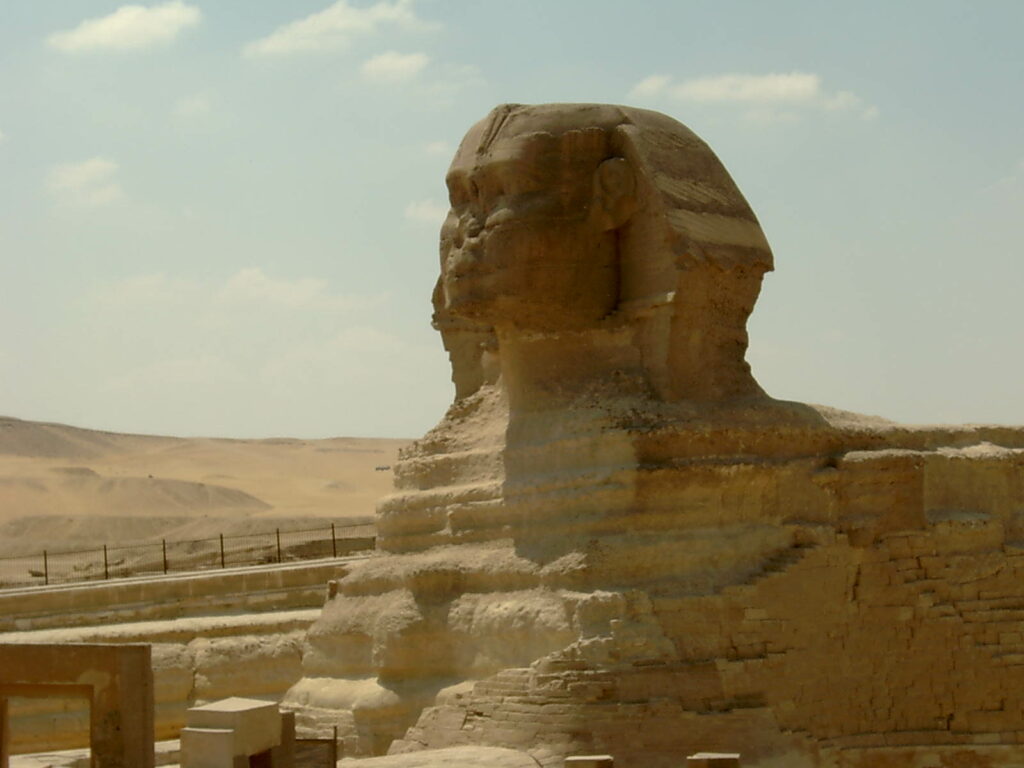Egypt’s capital city, Cairo, is a bustling, historic city that provides a distinctive fusion of historic landmarks and contemporary attractions. The Pyramids of Giza, the Sphinx, and the Egyptian Museum are just a few of the world’s most well-known sites that can be found in Cairo, also called the “City of a Thousand Minarets” or “City of a Thousand Minarets”.
Cairo is not only a vibrant metropolis with a vibrant arts and entertainment scene, but it also has a rich past and culture. There are numerous traditional markets, or “souks,” throughout the city where tourists can purchase for trinkets, spices, and handmade goods. Explore the hip neighborhoods of Cairo, like Zamalek and Maadi, which are teeming with upscale stores, eateries, and coffee shops, for a sample of contemporary Cairo.
Cairo serves as the starting point for a variety of scenic cruises and outings on the Nile River. The Valley of the Kings can be explored, the ancient temples of Luxor and Karnak can be seen, or visitors can take a felucca journey along the river.
Cairo is still a must-visit location for tourists looking for an authentic and unforgettable experience of Egypt and its rich culture and heritage, despite its difficulties like traffic congestion and pollution. In this article, we will list what we feel are the must see tourist attractions when you visit Cairo.
The Pyramids of Giza
The only remaining wonder of the ancient world, the Pyramids of Giza are among the most famous structures in the entire globe. The Fourth Dynasty of the Old Kingdom, which is when these enormous buildings were constructed, is located on the outskirts of Cairo, Egypt.
The Great Pyramid, which is the tallest of the three pyramids and rises at 147 meters, was built for Pharaoh Khufu. (481 feet). The two other pyramids, which are slightly smaller in height, were constructed for Khufu’s sons, Khafre and Menkaure.
Millions of limestone and granite blocks were used in the building of these pyramids, resulting in symmetrical structures that are a remarkable engineering and design accomplishment. Researchers are still unsure of how the ancient Egyptians managed to build such enormous structures; ideas range from the use of ramps and pulleys to the possibility of extra-terrestrial intervention.
The Pyramids of Giza continue to be a well-liked tourism destination today, luring tourists from all over the world to marvel at their enormous size and magnificent construction. They continue to pique the curiosity of people all over the world and serve as evidence of the creativity and skill of the ancient Egyptians.
The Great Sphinx
On the Giza Plateau, to the west of the Giza Pyramids in Egypt, stands the enormous limestone monument known as The Great Sphinx. Around 2500 BC, during the Fourth Dynasty of the Old Kingdom, it is thought to have been constructed under Pharaoh Khafre.
The statue is carved to resemble a mythical creature with a lion’s torso and a human’s head. It is 20 meters (66 feet) tall. It is assumed that it acted as a guardian of the necropolis as well as a representation of the pharaoh’s strength and dominance.
The Great Sphinx is incredibly well-preserved despite being more than 4,500 years old. Over the ages, it has endured erosion and damage, losing its nose in the process.
The Great Sphinx is still a well-liked tourist destination and one of Egypt’s most recognizable and iconic monuments. It continues to hold people’s attention on a global scale, and both academics and tourists are fascinated by its mysteries and secrets.
The Egyptian Museum
One of the most well-known museums in the world is the Egyptian Museum, which is situated in Cairo, Egypt. Founded in 1902, it houses more than 120,000 artifacts that offer a window into the complex past and society of ancient Egypt.
A sizable collection of relics from ancient Egypt, including mummies, sarcophagi, statues, jewelry, and hieroglyphics, can be found in the museum. The King Tutankhamun treasures, which include his golden death mask, and the Royal Mummies Hall, which contains the mummified remains of several pharaohs and their consorts, are some of the most well-known objects in the museum.
The extensive collection of the museum is divided into two levels and is organized chronologically, allowing visitors to travel through time and discover the various periods of ancient Egyptian history. In order to maintain and safeguard the museum’s priceless artefacts, the building also houses a library and a conservation center.
Visitors to the Egyptian Museum can anticipate being in awe of the extraordinary artistry and craftsmanship of ancient Egypt and learning more about this intriguing culture. For anyone intrigued in prehistoric history and archaeology, it is a must-visit location.
The Citadel of Saladin
In the heart of Cairo, Egypt, on a hilltop, stands the enormous fortification known as the Citadel of Saladin, also called the Citadel of Cairo. Saladin, the Ayyubid sultan, who used it as a defensive fortress to defend the city from invaders, constructed it in the 12th century.
With its massive stone walls, imposing gateways, and turrets, The Citadel is one of the most striking representations of medieval Islamic military architecture. The National Military Museum, the Police Museum, and a number of other significant historical structures are also housed there.
The Citadel has been an important part of Egypt’s past for many years, acting as a fortress, a royal residence, and a jail. It continues to be a well-liked tourist destination today, luring tourists from all over the world to admire its stunning architecture and discover its fascinating past.
The Citadel of Saladin, which still stands as a representation of Egypt’s rich cultural legacy, is a testament to the creativity and skill of the medieval Islamic architects.
Khan el-Khalili Bazaar
In the center of Cairo, Egypt’s Islamic capital, is the renowned Khan el-Khalili Bazaar. The bazaar, which dates back to the 14th century, is a bustling gathering place where locals and visitors equally come for a distinctive shopping experience.
The bazaar is an intricate maze of small lanes filled with stores and merchants offering everything from traditional handicrafts, spices, jewelry, and trinkets to fabrics, clothing, and antiques. A fun and genuine shopping experience can be had by customers by haggling with vendors for the best rates.
Along with shopping, Khan el-Khalili is a well-liked destination for tourists to eat and consume traditional Egyptian fare like tea and shisha while taking in the sights and sounds of the bustling market.
The bazaar has historical significance in addition to its commercial significance because it was a significant trading center for traders traveling along the Silk Road. The market has endured through the ages and has come to represent Cairo’s extensive cultural legacy.
In general, Khan el-Khalili Bazaar should be visited by anyone who wants to experience Cairo’s dynamic vitality and distinctive culture.
Al-Azhar Mosque
Located in the center of Cairo, Egypt, the Al-Azhar Mosque is one of the most significant Islamic religious sites in the entire globe. It was created by the Fatimid Caliphs in the tenth century, and since then, it has developed into a hub for Islamic education and study.
With its substantial stone walls, domed roofs, and elaborate decorations, the mosque is renowned for its impressive design. Additionally, it is home to one of the oldest universities in the world, Al-Azhar University, which has had a significant impact on Islamic thought and society throughout the ages.
The Al-Azhar Mosque is a crucial representation of Egypt’s rich cultural legacy and a reminder of its longstanding commitment to Islamic learning and culture. Muslims from all over the world still travel there to learn and worship in its revered spaces, making it a significant location.
In addition to taking in the mosque’s stunning architecture and intriguing history, visitors can also take in the tranquil setting and spiritual energy that permeate the building.
Old Cairo
Old Cairo, also referred to as Coptic Cairo, is an ancient area found in Cairo, Egypt’s southeast. Numerous historic structures, including churches, monasteries, and mosques, many of which are from the early Islamic period, can be found in the neighbourhood.
The Coptic Museum, which houses a sizable collection of Coptic art and artefacts, including textiles, manuscripts, and icons, is one of the most important sights in Old Cairo. Among the earliest churches in Egypt are the Hanging Church and the Church of St. George, which is incorporated into the Roman Tower of Babylon.
The Ben Ezra Synagogue, which dates to the ninth century and is thought to be one of Egypt’s earliest synagogues, is also located in Old Cairo. The Amr Ibn Al-As Mosque, which is located in the neighbourhood, is also one of Egypt’s earliest mosques.
Overall, the Old Cairo neighbourhood is an intriguing and culturally significant one that gives visitors a window into the city’s rich history and legacy.
The Museum of Islamic Art
A significant and extensive collection of Islamic art can be found at the Museum of Islamic Art in Cairo. Since its founding in 1903, the museum has amassed a collection of more than 102,000 items spanning 14 centuries of Islamic art.
An impressive piece of art, the museum’s architecture combines contemporary and conventional Islamic elements. The structure has two wings, a courtyard in the center, and is encircled by a verdant garden. It has a central dome.
The exhibits are arranged both chronologically and thematically inside the museum to highlight the different artistic styles of the Islamic world. A variety of items, including pottery, glass, metal, textiles, manuscripts, and woodwork, are part of the collection. Visitors can take in the exquisite calligraphy, complex geometric designs, and breathtaking decorative motifs that are typical of Islamic art.
A useful resource for researchers and academics, the museum also has a library with over 30,000 books on Islamic art and culture.
For anyone intrigued in Islamic art and culture, the Museum of Islamic Art in Cairo is a must-visit location. It provides a fascinating look into the rich creative tradition of the Islamic world and is evidence of the lasting influence of Islamic art.
The Nile River
The Nile River, which flows over 4,000 miles from its source in Burundi to its mouth in the Mediterranean Sea, is the longest river in the globe. Egypt’s iconic river, which supplies water for transit, tourism, and farmland, is the country’s lifeblood. Travelers to Cairo have the opportunity to take a boat journey along the Nile River while taking in the breathtaking views of the city and its surroundings. Along the way, they can experience some of the famous sites along the river, including the Valley of the Kings, the Luxor Temple, and the Aswan Dam. A wide variety of wildlife, including crocodiles, hippos, and different bird types, can be found along the Nile River.
Visitors can go on a safari along the river to see these incredible animals in their native environment. Exploring the Nile River’s beauty and significance is a crucial component of any journey to Cairo because it is a symbol of life and vitality.






















